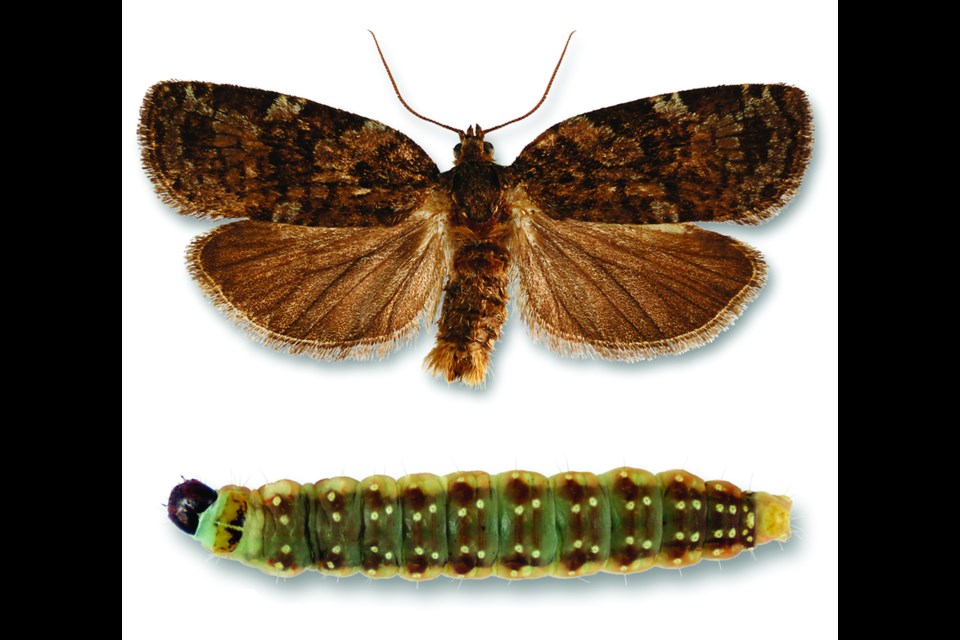THUNDER BAY — A forest pest that causes severe damage to fir trees is overdue for a big rebound in Northwestern Ontario, but its advance this year may have been slowed by hot weather last year.
Although there are reports of impacted tree stands around the Thunder Bay area, "it's a bit of a surprise" there hasn't been more defoliation from the spruce budworm, said Taylor Scarr, director of the Integrated Pest Management Division at the federal government's Great Lakes Forestry Centre in Sault Ste. Marie.
The Eastern Spruce Budworm feeds mainly on balsam fir and white spruce, and to a lesser extent on red spruce and black spruce. Trees typically die after four or more years of severe defoliation.
In the spring, the larvae emerge just before bud outbreak in the spring and begin feeding on the needles of their host trees. By mid-to-late June, they finish feeding and metamorphose into pupae, usually within old foliage. In the next stage, adult moths emerge from late June to early August and lay eggs in clusters of 10 to 150 on the needles of host trees.
Newly-hatched larvae will spin cocoons in protected areas on the host tree, where they spend the winter.
"Last year, we had a fairly large population that showed up with severe defoliation from about Sault Ste. Marie to Kakabeka Falls and then parts of Northwestern Ontario," Scarr told TBnewswatch in a recent interview.
He said there are spotty infestations currently, but most trees in the region remain clear of budworms.
"We think it's probably because of very high temperatures last year. When the population last summer finished feeding, it went into the pupal stage, and into the adult moth stage, then laid its eggs. And it seems like the larvae that came from those eggs – the caterpillars – may have died in the high heat."
Scarr said two scientists from the GLFC are working with an Ontario Ministry of Natural Resources specialist to try to determine if the theory is correct.
The MNR is still collecting data about the budworm infestation this year, but last year it identified about 119,000 hectares of moderate-to-severe defoliation by the budworm in the Northwest, mostly in the Nipigon-Geraldton district.
That's a small area compared with the amount of damage that occurred in extensive spruce budworm outbreaks such as those that occurred in the 1950s and 1980s.
But Ricardo Velasquez, a forested ecosystems science specialist with the ministry, said ongoing monitoring indicates defoliation levels are trending upwards in the Northwest, although "it's still a relatively small amount compared to what the Northeast has been experiencing over the last three or four years."
Monitoring includes a combination of aerial mapping and biomonitoring using pheromone insect traps.
"You might have seen similar traps around Thunder Bay with the emerald ash borer monitoring," Velasquez said. "They're made of corrugated plastic and they are hung from trees."
The MNR doesn't consider the current extent of the budworm infestation in the Northwest to be enough to warrant mitigation measures including the application of an insecticide.
Since large outbreaks tend to occur every 30 to 40 years, Velasquez noted "We've been expecting an outbreak for awhile, because our last big outbreak was in the 80s."
In the spring, property-owners with white spruce or balsam fir trees in their yards may notice brownish-coloured caterpillars with some white dots on them, and a shiny black head.
The insects prefer to eat the newer needles.
Natural Resources Canada says the spruce budworm has a significant impact on Canada’s forests, as major outbreaks have destroyed millions of hectares of valuable timber.
Evidence of an infestation may include the destruction of buds, abnormal spreading of new twigs, defoliation of current-year shoots, or the presence of large numbers of larvae suspended from strands of silk.
Defoliation begins at the top of the tree, and causes severely-affected trees to turn a rust colour as the needles dry out.
Vince Rutter, a forester and arborist and owner of Rutter Urban Forestry, said Wednesday he's seeing significant defoliation near Mountain Road, the 15th Side Road, Oliver Road and other areas where there are lots of spruce trees.
"It's literally everywhere. It's patchy, but more places than not you will see lots of damage and you can see it very easily. Just by driving, you see spruce trees that are looking brown at the tips. And if you get closer you can see lots of webbing and bare twigs."
Rutter said since the larvae are pupating now, and about to change into moths, there's little that a property-owner can do to control the insects at this point.
"But if we get drought conditions, it will be very stressful for trees, especially if they're missing a lot of foliage. So for individual trees, keeping the soil watered throughout a drought is about the only thing you can do."
He said a biological insecticide with B.t., a species of bacteria, is effective against the budworm if it's applied at the right time, which is early June.
It can be purchased over the counter, but he pointed out that "you can't spray it high enough to get good coverage on larger trees."
